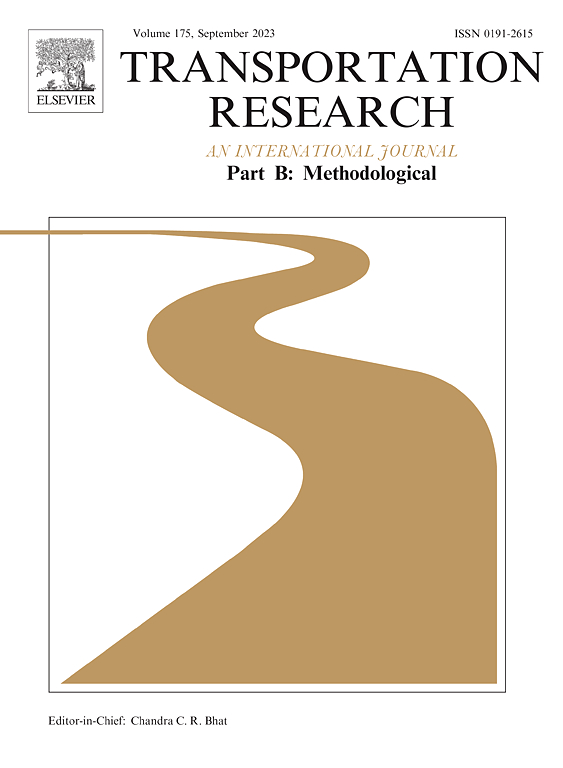Equilibrium horizontal queues and a paradox of tolling
IF 5.8
1区 工程技术
Q1 ECONOMICS
引用次数: 0
Abstract
This paper shows that, in a static traffic model with elastic demand, increasing a toll may raise the equilibrium trip rate through a network. The result is obtained in models with horizontal queues and rules about merges and diverges assumed in the Cell Transmission Model for Network Traffic. The paper looks at three networks: (i) a road with a fixed bottleneck at the end; (ii) a road with a “triggerneck” diverge; and (iii) a ring road with two on-ramps and two off-ramps. In the triggerneck network, a toll increase may raise the total trip rate when traffic using an exit with bottleneck has a lower value of travel time savings than traffic bypassing the bottleneck. In the ring road, a toll increase may raise the total trip rate when the initial equilibrium is hypercongested. The derivations use an extensible “recipe” for analysis of networks with horizontal queues. Many diagrams and numerical examples are provided to illustrate.
均衡水平队列与收费悖论
研究表明,在具有弹性需求的静态交通模型中,增加通行费可以提高通过网络的均衡行程率。这一结果是在具有水平队列的模型和网络流量单元传输模型中假定的合并和发散规则下得到的。本文研究了三种网络:(i)一条在终点有固定瓶颈的道路;(ii)有“诱因”岔道的道路;(三)一条有两条上匝道和两条下匝道的环城公路。在触发颈网络中,当使用具有瓶颈的出口的交通比绕过瓶颈的交通节省的旅行时间值更低时,通行费的增加可能会提高总行程率。在环形公路上,当初始平衡状态为超拥挤时,通行费的增加可能会提高总出行率。这些推导使用可扩展的“配方”来分析具有水平队列的网络。文中提供了许多图解和数值实例来说明。
本文章由计算机程序翻译,如有差异,请以英文原文为准。
求助全文
约1分钟内获得全文
求助全文
来源期刊
CiteScore
12.40
自引率
8.80%
发文量
143
审稿时长
14.1 weeks
期刊介绍:
Transportation Research: Part B publishes papers on all methodological aspects of the subject, particularly those that require mathematical analysis. The general theme of the journal is the development and solution of problems that are adequately motivated to deal with important aspects of the design and/or analysis of transportation systems. Areas covered include: traffic flow; design and analysis of transportation networks; control and scheduling; optimization; queuing theory; logistics; supply chains; development and application of statistical, econometric and mathematical models to address transportation problems; cost models; pricing and/or investment; traveler or shipper behavior; cost-benefit methodologies.

 求助内容:
求助内容: 应助结果提醒方式:
应助结果提醒方式:


